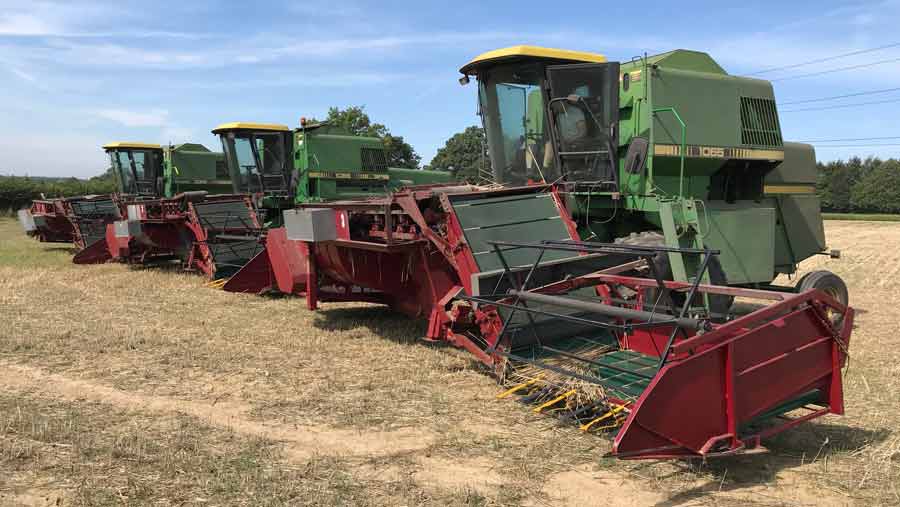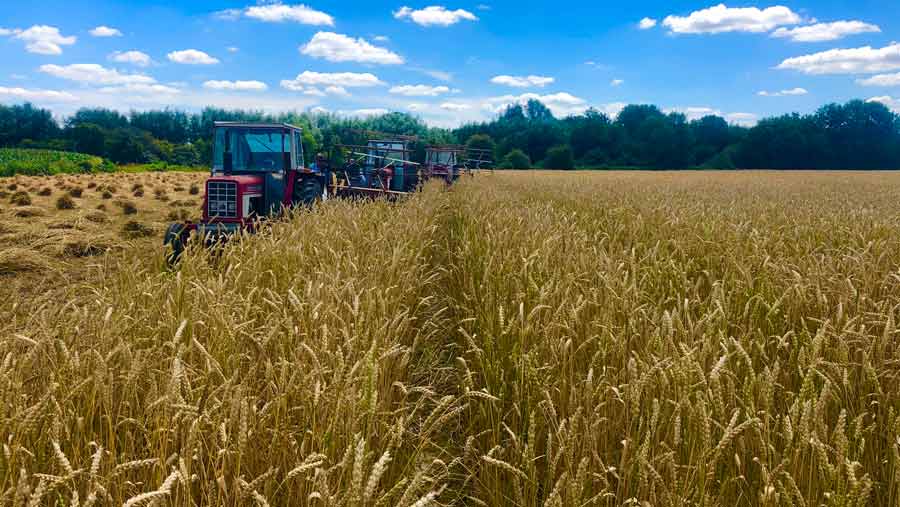Mechanisation imperative to secure UK thatching straw future
 © MAG/Oliver Mark
© MAG/Oliver Mark Indigenous supplies of thatching straw could be under threat if the sector’s vintage machinery is not brought up to date.
Concerns over the sustainability of UK production were first aired by Historic England, the government department responsible for protecting heritage buildings, following a dire 2020 harvest.
Though that proved to be a challenging year across the arable sector, problems in the thatching sector are deeply rooted, with growers battling a limited availability of tall wheat varieties, their propensity to lodge in heavy rain and wind, and a lack of seasonal workers for what remains an extremely labour-intensive process.
See also: Video: Threshing wheat for thatching straw
But Historic England is keen to address the issue of mechanisation, with 80% of UK growers still using archaic binders to cut the partially ripe crop – typically Maris Widgeon wheat – before stooking the sheaves by hand in the field.
These are then transferred to a barn ready for the slow and dusty task of threshing, which involves more ancient machinery.
Rough estimates put the labour involved in the conventional harvesting process at a staggering 54 hours/ha.

© Packham Thatchers
Looking at the options
Agricultural engineering consultant Dr Andy Scarlett has compiled a report on current practices in a bid to reduce the amount of manual handling required.
“The sector is unlikely to attract any commercial manufacturers willing to invest in the research and development of new machinery, so growers effectively have the options of running cheap, old kit, repurposing newer alternatives to suit straw production, or building something themselves,” says Andy.
“We need to find solutions that are financially viable and not detrimental to the quality of the end product.
“Given that, the focus for small-scale producers should be on replacing the 6ft cutterbars, old knotters and canvas belts of the most common binders with modern alternatives, for which spare parts are more readily available.”
However, a couple of bigger growers have taken matters into their own hands by investing in the development of bespoke mechanised systems.
One of those is Essex Farms, which grows up to 100ha of Maris Huntsman wheat as part of a sprawling 2,700ha operation.
Harvesting involves first removing the grain with a 7.5m Shelbourne Reynolds stripper header on one of the firm’s three Claas Lexion combines.
The straw is then cut by a modified swather, with the 5.5m header adapted for side discharge.
This jettisons the crop into windrows, with air jets mounted at the end of the table turning the stems through 45 to 90deg.
As it is sold as long straw – with the leaves left on – this can then be collected by two John Deere variable chamber balers, before being left outside to season for up to 10 days and stacked in the shed.
Turgis Court Farm in north Hampshire takes a different approach.
Though the crop – in this case triticale – is stripper headed in similar fashion, it is then harvested with three home-built combine headers that comb the straw to remove leaf matter and package it into bundles.
These are loaded by hand into a custom in-field crate and strapped with metal bands to form 75-95kg bales that can be stored and sold directly to thatchers.
Niche sector
Stooks of wheat sheaves are an iconic image of the British countryside, but producers of this increasingly niche building material are disappearing.
Almost 65% of the remaining growers are based in the South West, and 30% in East Anglia and the South East, but the vast majority of those still use a harvesting system that, except for swapping horses for tractors, has hardly changed in nearly a century.
Of those, 60% are planting less than 25ha each year, making it little more than a cottage industry.
In fact, just 12% of growers produce more than 60ha of straw annually and 40% of growers account for 80% of straw production – which leaves the sector in a precarious long-term position.
Historic England hopes to change that dynamic, and the first stage of its work was to invite a cohort of the country’s growers to a meeting in Pewsey, Wiltshire, to thrash out opportunities to mechanise the harvesting process.

